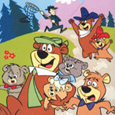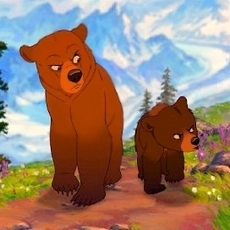Media Headquarters Film & Television (December 24, 2006), Genius Entertainment (January 20, 2009), single disc, 47 mins plus supplements, letterbox, Dolby Digital 2.0, Not Rated (parental guidance suggested for hunting sequences), Retail: $14.95
Storyboard:
A Polar Bear tries to teach her two cubs about life in the Arctic and the new challenges they face due to the interference of man.

The Sweatbox Review:
The Great Polar Bear Adventure refers to a story a new momma bear tells her two cubs about another bear’s great adventure. It begins with a polar bear love story between a female polar bear named Ikuk and her mate. They meet in the spring and it is love at first sight. Months later, Ikuk moves inland to find a den to give birth to her two cubs, Cassie and Asak. The cubs are born and they feed off their mother’s milk until they are large enough to go to the shore. Their mother takes them to the sea ice to teach them how to hunt, but the ice has melted and there are few seals to find. Because of the lack of food, their final resort is a place called Bear Hill. At Bear Hill, two-legged tourists contemplate the bears as they play around in search of food. The two cubs, after chasing a Tundra Buggy, get separated from their mother and discover a town with its trash heap that attracts other polar bears. The mother bear, desperate to find her lost cubs, goes deeper into human territory and discovers more about her human neighbors in the process.
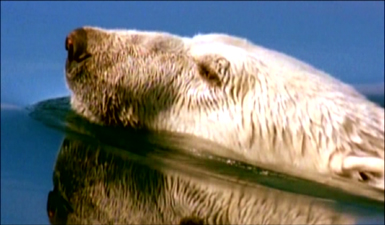
Much has been made in recent years about the plight of the polar bears in the Arctic. Many environmental campaigns point to the Poles as regions that are most quickly suffering the effects of increased Global Warming. In the South Pole, the plight of the great emperor penguins has been highlighted frequently in films and documentaries such as March of the Penguins. In the north, the plight of the polar bears has increasingly become the symbol to the problems there, most recently in the documentary Arctic Tale. There are between 22,000 and 25,000 polar bears left in the great north and they are being threatened by increased Global Warming that is destroying their traditional hunting grounds. Bears need the pack ice to hunt for their food of choice, seals. With the ice melting earlier every year, their window of opportunity for hunting has dwindled making them store less food for survival during the winter months. Last year, the US Government finally listed polar bears as a threatened species and they are now under special protection. However, conservation efforts are now focused on Canada where legal hunting of polar bears is allowed (with some limitations) and are now under review by the federal government. It is then fitting that The Great Polar Bear Adventure is produced by the Canadian company Media Headquarters in partnership with CBC Television, Discovery Kids, and France 3.

The footage in the film is all taken from documentary film footage of polar bears living and hunting in the Arctic Tundra. The filmmakers compiled documentary footage of the bears from the past thirty years from various sources around the world. Since all polar bears essentially look alike, it was easier for the filmmakers to put the footage together to make a cohesive story. The filmmakers then took their stock footage to animators who cleaned up the image from grain to make it look like it was all from the same source. Close-ups of zoo bears were used in addition to the other footage. In the film, the live action bears speak with the help of CGI. The animation in this case was done by Optix Digital Pictures, an animation and special effects company from Toronto. The animation is usually restricted to the mouths, although this also required for the rest of the face to be animated. The documentary footage of the Arctic is not as stunning as in other documentaries like Planet Earth, but the beauty of the stark Arctic is still appreciated. Unlike Planet Earth, however, we get to seem more of the direct human impact in the Arctic region. We see trash heaps, towns, bear traps and tourists all making their impact on the local bear populations. We also get to see some conservation efforts towards the end of the film, although they are not totally explained since the story is from the bear’s point of view.
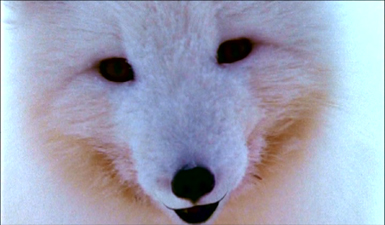
I like that the story here is taken from the bear’s point of view. In fact, the narrator (voiced by Megan Follows) is a bear who is telling the story to her two young cubs. She is not omniscient and cannot explain everything that happens. As a viewer, with a direct knowledge of Global Warming and its effects, I was engaged in knowing what was causing things. However, since this is a story for kids, I think the film lacks some information on how humans are affecting their habitat. I do not think most kids will get the link between humans and less ice for the bears, for example. The film almost requires a parent or teacher to explain what is happening. There is also an unnecessary villain in the story with the rival polar bear who attacks the family. While the motivations behind the bear are attributed to man, I felt this was an unnecessary addition to the story. Where the film does succeed is in the realism of life for the bears and the danger that towns and maybe even ecotourism have on the bears’ lives. When we see a polar bear hunt a seal, the attack is implied but the aftermath and carnage is very real. When the bears go to the trash heap or to Bear Hill, we are able to see how dangerous our encroachment of their habitat has become for these bears. Parents should be warned that the hunting sequence may be too graphic for young viewers.
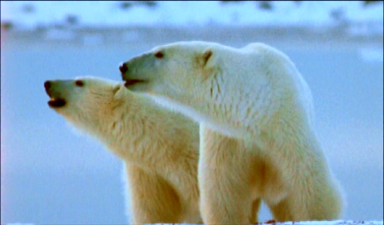
Is This Thing Loaded?
Included in the disc is a short documentary called The Making of The Great Polar Bear Adventure (9:36) which is narrated by director Robert Cohen. In the brief documentary, the filmmakers explain how they obtained the footage of the bears and how they put the pieces together to form a cohesive story. It was interesting to note that the footage was taken from many different countries and from a span of several decades. One notable film sequence obtained and shown in the film, related to the rival bear Krakush, was a black and white sequence showing humans hunting and capturing bears in the early part of the century. The powerful footage explains the character’s introduction in the film. What I found the most interesting in the documentary was how the filmmakers obtained close-ups of polar bears in the zoos. While it may sound like a simple task, the director had to wait two days before getting the footage he needed for the film. This was due to the lack of cooperation by the bears. Overall, it’s a brief but informative documentary on the making and the vision behind the film.

Case Study:
The cover art for this release features a cute and cuddly CGI polar bear cub smiling at us at the top and a picture of the polar bear family at the bottom. The story is billed as “a journey the whole family will enjoy.” The case itself is a regular DVD keep case with two locking tabs. A cardboard slipcase is also included.
Ink And Paint:
While watching the footage, I noticed that it was not all from a single source. While the filmmakers did a great job at putting the different pieces together into one cohesive story, I still felt that it had been pasted together. The quality of the footage is similar, or at least has been altered to be similar, but I think the style of the footage dated some shots. It was more noticeable when humans started showing up in the story because we can tell when people are from based on what they are wearing. However, I must commend the digital team for doing a good job at putting it together. It is not something that hinders the enjoyment of the movie and kids will not be bothered by it at all. As for the quality of the picture, because they had to make everything of equal quality, the overall picture has a grainy quality to it. It looks just like old nature documentaries on television. Of course, the new close-ups of the polar bears are perfect. The CGI animation is simple and effective. It’s very similar to regular effects we already see on television. I should point out that the film has been released in a “matted” letterbox format.

Scratch Tracks:
The filmmakers did a good job at putting the voice cast and score together. Megan Follows is a great narrator and she provides a calm, soothing voice to the story. The two other noticeable voice actors are Howie Mandel as Pupa the arctic fox and Don Cherry as a husky. Overall, everyone does a good job in this department. The film has been released with one English Dolby Digital 2.0 track. No subtitles or alternate tracks are provided.

Final Cut:
The Great Polar Bear Adventure is an ecological parable. We see the trials and sufferings of a polar bear family trying to cope with an increasingly warmer Arctic region. With the unique point-of-view from the bear’s perspective, it’s an innovative approach to natural history documentaries. Children might enjoy the movie and maybe they will be able to connect with the two young cubs. However, I do feel that this is a type of film that requires adult guidance for some of the themes that are left unexplained. Parents should know that there is a hunting sequence of a seal in the film and younger, sensitive children may find the images disturbing. Overall, this is a decent story that will appeal to children and will teach them something about how we have affected animals’ habitats.

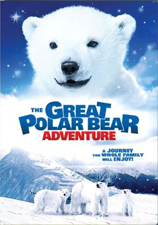 | ||
 |





